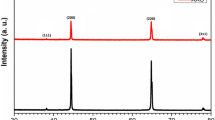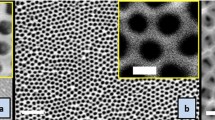Abstract
Nanoporous alumina is formed by two-step anodization process on an aluminum foil (99.99 %). Process of anodization allows to generate stable patches of nanoporous alumina and can affect the size and depth of the nanopores. By varying the parameters of anodization process we can control the growth of pores and their size. The properties of alumina film were studied by atomic force microscopy (AFM) and scanning electron microscope (SEM). The diameters of pores were found to be dependent on the applied voltage. Nanoporous alumina can be used as different membranes, test samples, template for nanostructured materials. The AFM is an appropriate method to study the size and depth of nanopores and periodicity of surface features.
Access provided by Autonomous University of Puebla. Download chapter PDF
Similar content being viewed by others
Keywords
1 Introduction
Atomic force microscopy (AFM) is an integral part of the research in the field of nanotechnology. AFM allows us to study the surface of various samples: the roughness of the surface and its local properties, and can provide information about the size of the grains, pores or particles. Depending on the method of study one can get (receive) the different information about the sample surface. Using AFM and SEM we can assess relative size and depth of nanopores.
The AFM was first described by [1] Binnig et al. as a new technique for imaging the topography of surfaces with high resolution. AFM was created as a solution to the limitations of the scanning tunnel microscope (STM), which usually applied to study conductive samples. The AFM method plays important role in surface physics studies and applies to study the most non conductive materials. The AFM allows us to study a variety of materials, not only in vacuum but also in air and in liquid [2].
Anodizied nanoporous alumina is well known to be formed by the anodizing (electrochemical oxidation) of aluminum in an electrolytic cell in which the aluminum acts as the anode. Size and depth of the pores can be controlled by voltage, different types of acids and anodization time [3, 4]. The type and the concentration of the electrolyte for a given voltage is to be selected properly to obtain self-ordered pore growth. Nanoporous materials have promising properties for applications in such areas as biosensing [5], chemical sensing [6] or nanotemplates [7], etc. In particular, capillary condensation can be studied in nanoporous materials with pore sizes slightly larger than the molecular diameter of an adsorbate.
2 Experimental Part
Nanoporous alumina was obtained by a two-step anodization. The surface of high purity aluminum foil (99.99 %) was polished and cleaned in an ultrasonic bath after thermal annealing at 500 °C (3 h). Also process of electro-chemical polishing of the sample was performed in solution H3PO4/CrO3/H2O (3.3:0.7:1 part) with the next parameters: T = 70–80 °C, t = 30 min, I = 100 mA, V = 3–4 V. It was done to remove impurities from the surface and to polish the surface. The anodization process was carried out in a special cell using oxalic acid (COOH)2 (0.3 M). Then aluminum foil was anodized under constant voltage conditions (30 V) into contact with solution at area of 0.1–0.2 mm2. The duration of the first anodization was 12 h. Then formed oxide layer was selective dissolved in H3PO4/CrO3 solution (T = 70–80 °C). Second anodization has duration of 5 min and was conducted under the same conditions as the first anodization. Then sample was rinsed with distilled water.
Surface of obtained samples was investigated by AFM Ntegra Therma (NT-MDT) and SEM Quanta 3D 200i (FEI Company). The tapping mode AFM was used (Fig. 111.1). The intermittent tapping mode was developed [8–10] in order to overcome the limitations of contact mode (Fig. 111.2). Here the cantilever was allowed to oscillate at a value close to its resonant frequency. When the oscillations occur close to a sample surface, the probe will repeatedly engage and disengage with the surface, restricting the amplitude of oscillation. As the surface is scanned, the oscillatory amplitude of the cantilever will change as it encounters differing topography. By using a feedback mechanism to alter the z-height of the piezocrystal and maintain constant amplitude, an image of the surface topography may be obtained in a similar manner as with contact mode imaging [11, 12].
3 Results and Discussion
Figure 111.3 shows the topography image of samples after the first anodization. The size of the grains determined by AFM was found in the range from 50 to 100 nm.
After selective dissolution of the formed oxide layer in H3PO4/CrO3 solution uniformly distributed pores are appear on the sample surface. The average size of pores is about 50 nm (Fig. 111.4).
We also used phase mode (Fig. 111.5) for studying of samples surface. The principle of phase mode consist in the following: if the phase lag of the cantilever oscillation relative to driving signal is recorded in a second acquisition channel during imaging in intermittent contact mode, noteworthy information on local properties, such as stiffness, viscosity, and adhesion, can be detected that are not revealed by other AFM techniques. It is good practice to improve interpret the images obtained. For this mode it was used probes which have resonant frequency of 87–230 kHz. If we have high resonant frequency of probe we can get better phase contrast image.
Figure 111.6 shows the topography image of samples after the second anodization. We assessed the size of nanopores using the software of our microscope for surface morphologies of samples, as shown in Fig. 111.6.
Figure 111.7 shows SEM image and analysis of the elemental composition of Al2O3 surface after first anodization.
As it is shown in Fig. 111.4, there are many large grains allocated against the even background produced as a result of anodization. Elemental analysis (Fig. 111.8) revealed that these grains are not remnants of alumina, but the pure aluminum.
4 Conclusions
We have obtained nanoporous alumina films in two-stage process of anodization using oxalic acid. A special electrochemical cell was made for etching experiments. The morphology of nanoporous alumina was studied by atomic force microscopy and scanning electron microscopy. The size of pores and the interpore distance is coinciding with the known literature data [13]. The AFM is the proper research method for study of morphology of nanoporous alumina surface and allow to develop methods of nanoporous alumina synthesis which is promising matrix to produce different nanostructured materials.
References
Binnig G, Quate CF, Berger Ch (1986) Atomic force microscope. Phys Rev Lett 56(9):930–933
Richard Bowen W, Hilal N (2009) Atomic force microscopy in process engineering: an introduction to AFM for improved processes and products, p 352
Lee W, Schwirn K, Steinhart M, Pippel E, Scholz R, Gosele U (2008) Structural engineering of nanoporous anodic aluminium oxide by pulse anodization of aluminium. Nat Nanotechnol 3:234–239
Wang Z, Brust M (2007) Fabrication of nanostructure via self-assembly of nanowires within the AAO template. Nanoscale Res Lett 2:34–39
Pacholski C, Sartor M, Sailor MJ, Cunin F, Miskelly GM (2005) Biosensing using porous silicon double-layer interferometers: reflective interferometric Fourier transform spectroscopy J Am Chem Soc 127:11636
Gao J, Gao T, Li YY, Sailor MJ (2002) Langmuir 18:2229
Li CP, Roshchin IV, Batlle X, Viret M, Ott F, Schuller IK (2006) J Appl Phys 100:074318
Hansma HG, Sinsheimer RL, Groppe J, Bruice TC, Elings V, Bezanilla M, Mastrangelo IA, Hough PVC, Hansma PK (1993) Recent advances in atomic-force microscopy of DNA. Scanning 15(5):296–299
Hansma HG, Cleveland JP, Radmacher M, Walters DA, Hillner PE, Bezanilla M, Fritz M, Vie D, Hansma HG, Prater CB, Massie J, Fukunaga L, Gurley J, Elings V (1994) Tapping mode atomic force microscopy in liquids. Appl Phys Lett 64(13):1738–1740
Zhong Q, Inniss D, Kjoller K, Elings V (1993) Fractured polymer/silica fiber surface studied by tapping mode atomic force microscopy. Surf Sci Lett 290:L688–L692
Pham QP, Sharma U, Mikos AG (2006) Electrospinning of polymeric nanofibers for tissue engineering applications: a review. Tissue Eng 12(5):1197–1211
Mo XM, Xu CY, Kotaki M, Ramakrishna S (2004) Electrospun P (LLA-CL) nanofiber: a biomimetic extracellular matrix for smooth muscle cell and endothelial cell proliferation. Biomaterials 25(10):1883–1890
Chu S-Z, Wada K et al (2005) Fabrication of ideally ordered nanoporous alumina films and integrated alumina nanotubule arrays by high-field anodization. Adv Mater 17:2115–2119
Author information
Authors and Affiliations
Corresponding author
Editor information
Editors and Affiliations
Rights and permissions
Copyright information
© 2013 Springer Science+Business Media Dordrecht
About this chapter
Cite this chapter
Alpysbayeva, B.E., Abdullin, K.A., Karipkhanova, A.A. (2013). Production of Nanoporous Alumina and Surface Studies by Atomic Force Microscopy. In: Jung, HK., Kim, J., Sahama, T., Yang, CH. (eds) Future Information Communication Technology and Applications. Lecture Notes in Electrical Engineering, vol 235. Springer, Dordrecht. https://doi.org/10.1007/978-94-007-6516-0_111
Download citation
DOI: https://doi.org/10.1007/978-94-007-6516-0_111
Published:
Publisher Name: Springer, Dordrecht
Print ISBN: 978-94-007-6515-3
Online ISBN: 978-94-007-6516-0
eBook Packages: EngineeringEngineering (R0)












